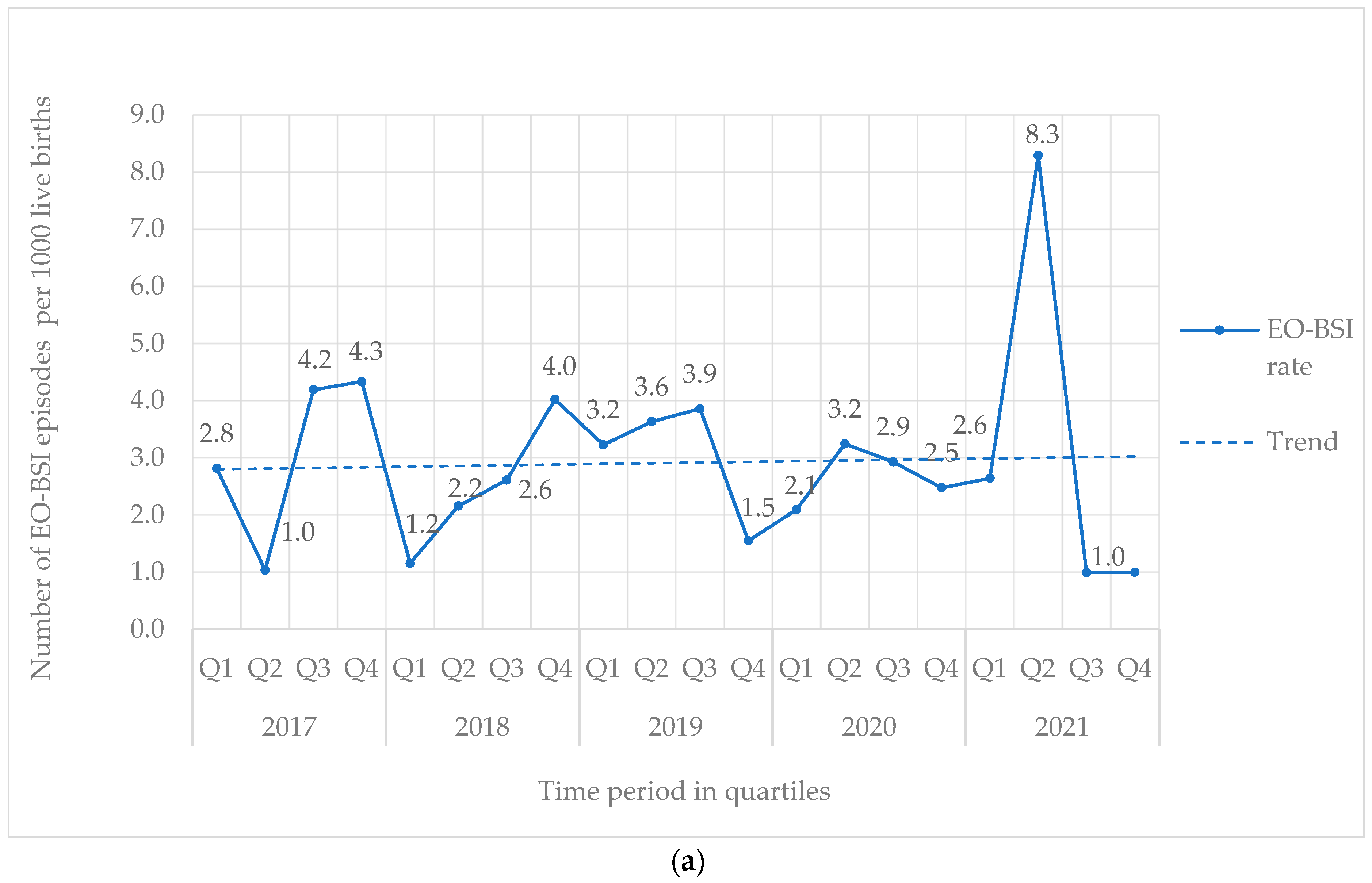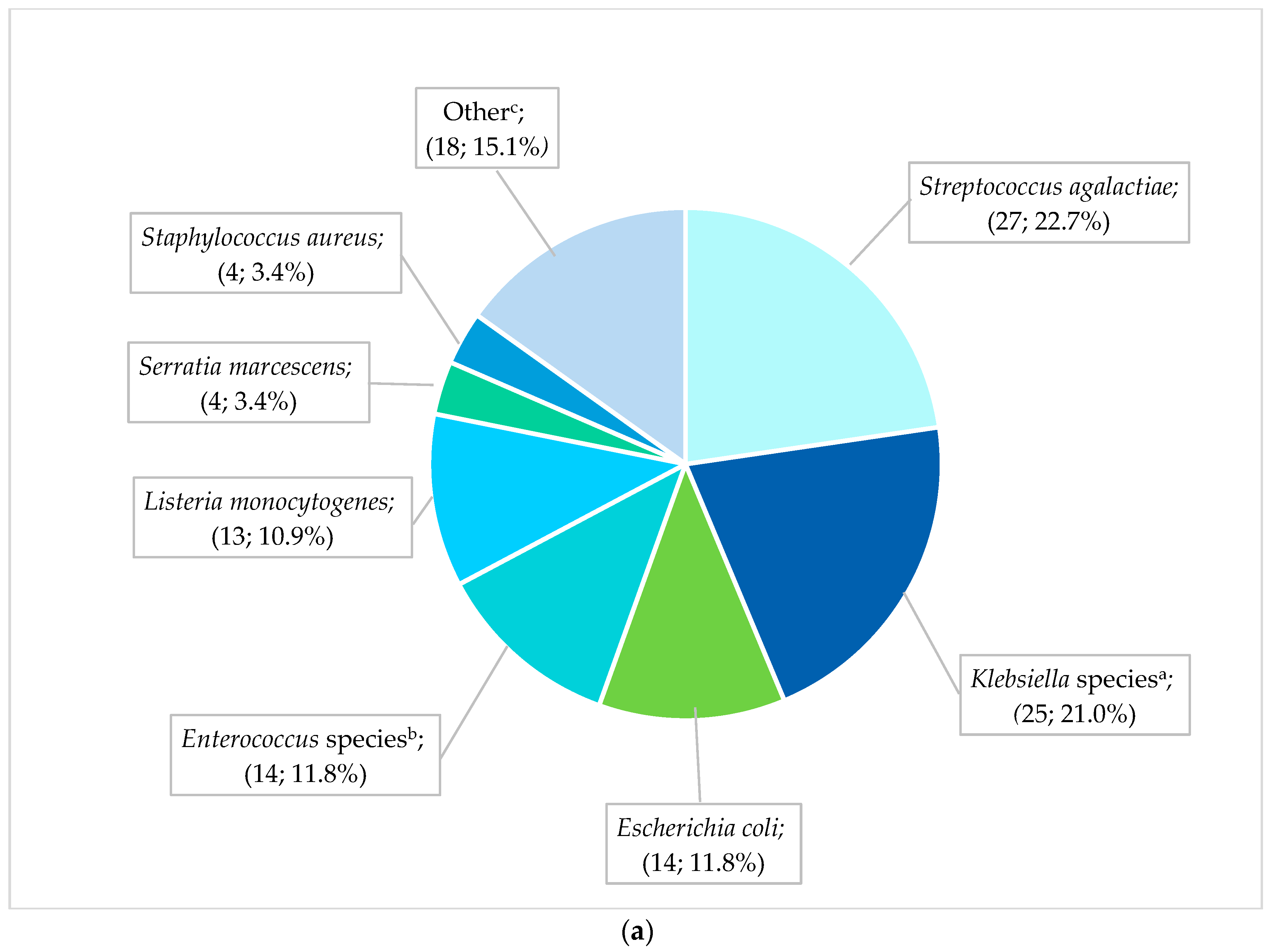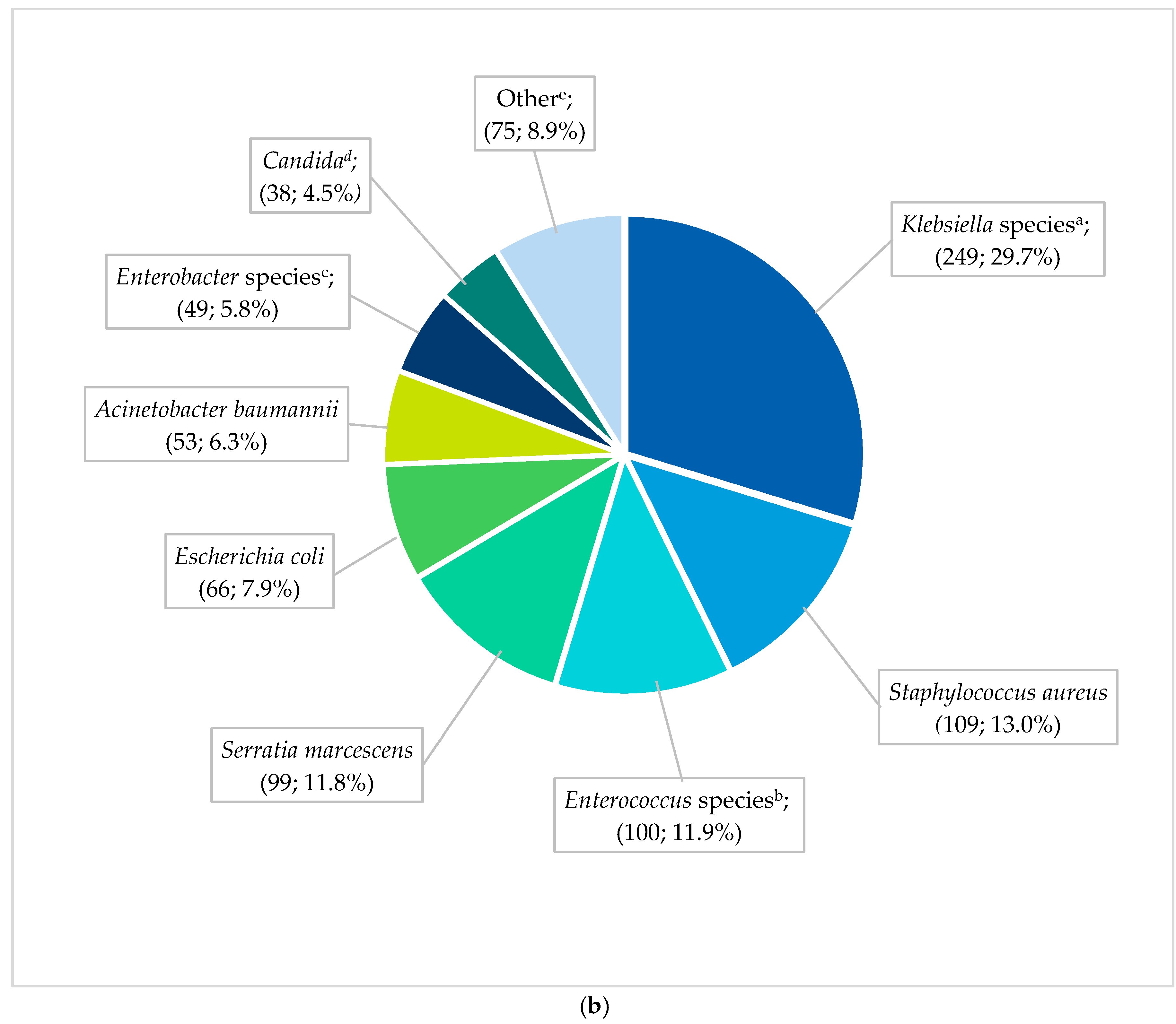Development of a Bloodstream Infection Surveillance Programme at a Resource-Limited South African Neonatal Unit
Abstract
:1. Introduction
2. Methods
2.1. Study Design and Population
2.2. BSI Episode Identification and Clinical Data Collection
2.3. Study Definitions
2.4. Study Approvals, Data Management, and Statistical Analysis
3. Results
3.1. Bloodstream Infection Classification and Incidence Density
3.2. Demographics of Neonates with Bloodstream Infection
3.3. Pathogen Spectrum and Antimicrobial Susceptibility of EO-BSIs
3.4. Pathogen Spectrum and Antimicrobial Susceptibility of HA-BSIs
3.5. Empiric Antibiotic Prescriptions and Antibiotic Concordance
4. Discussion
5. Conclusions
Author Contributions
Funding
Institutional Review Board Statement
Informed Consent Statement
Data Availability Statement
Acknowledgments
Conflicts of Interest
Abbreviations
| AMR | antimicrobial resistance |
| BSI | bloodstream infection |
| CRE | Carbapenem-resistant Enterobacterales |
| CRAB | Carbapenem-resistant Acinetobacter baumannii |
| ELBW | extremely low birth weight |
| EO-BSI | early onset bloodstream infection |
| EONS | early onset neonatal sepsis |
| ESBL | extended-spectrum β-lactamase |
| HA-BSI | healthcare-associated bloodstream infection |
| HAI | healthcare-associated infection |
| HIC | high-income country |
| IPC | infection prevention and control |
| IQR | interquartile range |
| LBW | low birth weight |
| LMIC | low- and middle-income countries |
| MRSA | methicillin-resistant Staphylococcus aureus |
| NHLS | National health laboratory service |
| NICU | neonatal intensive care unit |
| OR | odds ratio |
| TBH | Tygerberg hospital |
| VLBW | very low birth weight |
References
- Li, J.; Xiang, L.; Chen, X.; Li, S.; Sun, Q.; Cheng, X.; Hua, Z. Global, regional, and national burden of neonatal sepsis and other neonatal infections, 1990–2019: Findings from the global burden of disease study 2019. Eur. J. Pediatr. 2023, 182, 2335–2343. [Google Scholar] [CrossRef] [PubMed]
- World Health Organization. Global Report on the Epidemiology and Burden of Sepsis: Current Evidence, Identifying Gaps and Future Directions. Geneva. 2020. Available online: https://www.who.int/publications/i/item/9789240010789 (accessed on 22 February 2024).
- UNICEF United Nations Inter-Agency Group for Child Mortality Estimation. Levels and Trends in Child Mortality: Report 2023. 2023. Available online: https://data.unicef.org/resources/levels-and-trends-in-child-mortality-2024/ (accessed on 16 March 2025).
- Ranjeva, S.L.; Warf, B.C.; Schiff, S.J. Economic burden of neonatal sepsis in sub-Saharan Africa. BMJ Glob. Health 2018, 3, e000347. [Google Scholar] [CrossRef]
- Dramowski, A.; Bekker, A.; Cotton, M.F.; Whitelaw, A.C.; Coffin, S. Epidemiology of clinically suspected and laboratory-confirmed bloodstream infections at a South African neonatal unit. J. Infect. Dev. Ctries. 2021, 15, 943–952. [Google Scholar] [CrossRef]
- Russell, N.; Barday, M.; Okomo, U.; Dramowski, A.; Sharland, M.; Bekker, A. Early-versus late-onset sepsis in neonates—Time to shift the paradigm? Clin. Microbiol. Infect. 2024, 30, 38–43. [Google Scholar] [CrossRef]
- Cailes, B.; Vergnano, S.; Kortsalioudaki, C.; Heath, P.; Sharland, M. The current and future roles of neonatal infection surveillance programmes in combating antimicrobial resistance. Early Hum. Dev. 2015, 91, 613–618. [Google Scholar] [CrossRef]
- Schwab, F.; Geffers, C.; Bärwolff, S.; Rüden, H.; Gastmeier, P. Reducing neonatal nosocomial bloodstream infections through participation in a national surveillance system. J. Hosp. Infect. 2007, 65, 319–325. [Google Scholar] [CrossRef]
- Vergnano, S.; Menson, E.; Kennea, N.; Embleton, N.; Russell, A.B.; Watts, T.; Robinson, M.J.; Collinson, A.; Heath, P.T. Neonatal infections in England: The neonIN surveillance network. Arch. Dis. Child. Fetal Neonatal Ed. 2011, 96, F9–F14. [Google Scholar] [CrossRef]
- Madrid-Aguilar, M.; López-Herrera, M.C.; Pérez-López, J.; Escudero-Argaluza, J.; Santesteban-Otazu, E.; Piening, B.; Villate-Navarro, J.I.; Pijoán-Zubizarreta, J.I. Implementation of NeoKissEs in Spain: A validated surveillance system for nosocomial sepsis in very low birth weight infants. An. Pediatr. 2019, 91, 3–12. [Google Scholar] [CrossRef]
- Reddy, K.; Bekker, A.; Whitelaw, A.C.; Esterhuizen, T.M.; Dramowski, A. A retrospective analysis of pathogen profile, antimicrobial resistance and mortality in neonatal hospital-acquired bloodstream infections from 2009–2018 at Tygerberg Hospital, South Africa. PLoS ONE 2021, 16, e0245089. [Google Scholar] [CrossRef]
- Lebea, M.M.; Davies, V. Evaluation of culture-proven neonatal sepsis at a tertiary care hospital in Johannesburg, South Africa. SAJCH 2017, 11, 170–173. [Google Scholar]
- Abrahams, I.; Dramowski, A.; Moloto, K.; Lloyd, L.; Whitelaw, A.; Bekker, A. Colistin use in a carbapenem-resistant Enterobacterales outbreak at a South African neonatal unit. S. Afr. J. Infect. Dis. 2023, 38, 487. [Google Scholar] [CrossRef] [PubMed]
- Gezmu, A.M.; Bulabula, A.N.; Dramowski, A.; Bekker, A.; Aucamp, M.; Souda, S.; Nakstad, B. Laboratory-confirmed bloodstream infections in two large neonatal units in sub-Saharan Africa. Int. J. Infect. Dis. 2021, 103, 201–207. [Google Scholar] [CrossRef] [PubMed]
- Mashau, R.C.; Meiring, S.T.; Dramowski, A.; E Magobo, R.; Quan, V.C.; Perovic, O.; von Gottberg, A.; Cohen, C.; Velaphi, S.; van Schalkwyk, E.; et al. Baby GERMS-SA. Culture-confirmed neonatal bloodstream infections and meningitis in South Africa, 2014–2019: A cross-sectional study. Lancet Glob. Health 2022, 10, e1170–e1178. [Google Scholar] [CrossRef]
- Sands, K.; Spiller, O.B.; Thomson, K.; Portal, E.A.; Iregbu, K.C.; Walsh, T.R. Early-onset neonatal sepsis in low-and middle-income countries: Current challenges and future opportunities. Infect. Drug Resist. 2022, 15, 933–946. [Google Scholar] [CrossRef]
- Dramowski, A.; Lloyd, L.G.; Bekker, A.; Holgate, S.; Aucamp, M.; Reddy, K.; Finlayson, H. Neonatal listeriosis during a countrywide epidemic in South Africa: A tertiary hospital’s experience. S. Afr. Med. J. 2018, 108, 818–827. [Google Scholar] [CrossRef]
- Tygerberg Hospital Annual Report 2016; Tygerberg Hospital: Cape Town, South Africa, 2016. Available online: https://www.westerncape.gov.za/your_gov/153/documents/annual_reports/2016 (accessed on 22 February 2024).
- Centers for Disease Control and Prevention and the National Healthcare Safety Network. Bloodstream Infection Event (Central Line-Associated and Non-Central Line Associated Bloodstream Infection). 2024. Available online: www.cdc.gov/nhsn/xls/master-organism-com-commensals-lists.xlsx (accessed on 22 February 2024).
- Tsai, M.-H.; Hsu, J.-F.; Chu, S.-M.; Lien, R.; Huang, H.-R.; Chiang, M.-C.; Fu, R.-H.; Lee, C.-W.; Huang, Y.-C. Incidence, clinical characteristics and risk factors for adverse outcome in neonates with late-onset sepsis. Pediatr. Infect. Dis. J. 2014, 33, e7–e13. [Google Scholar] [CrossRef]
- Korang, S.K.; Safi, S.; Gupta, M.; Gordon, A.; Greisen, G.; Lausten-Thomsen, U.; Jakobsen, J.C. Antibiotic regimens for early-onset neonatal sepsis. Cochrane Database Syst. Rev. 2021, 5, CD013837. [Google Scholar]
- Cailes, B.; Kortsalioudaki, C.; Buttery, J.; Pattnayak, S.; Greenough, A.; Matthes, J.; Russell, A.B.; Kennea, N.; Heath, P.T. Epidemiology of UK neonatal infections: The neonIN infection surveillance network. Arch. Dis. Child. Fetal Neonatal Ed. 2018, 103, F547–F553. [Google Scholar] [CrossRef]
- Russell, N.J.; Stöhr, W.; Plakkal, N.; Cook, A.; Berkley, J.A.; Adhisivam, B.; Agarwal, R.; Ahmed, N.U.; Balasegaram, M.; Ballot, D.; et al. Patterns of antibiotic use, pathogens, and prediction of mortality in hospitalized neonates and young infants with sepsis: A global neonatal sepsis observational cohort study (NeoOBS). PLoS Med. 2023, 20, e1004179. [Google Scholar] [CrossRef]
- Shadbolt, R.; We, M.L.S.; Kohan, R.; Porter, M.; Athalye-Jape, G.; Nathan, E.; Shrestha, D.; Strunk, T. Neonatal Staphylococcus Aureus sepsis: A 20-year Western Australian experience. J. Perinatol. 2022, 42, 1440–1445. [Google Scholar] [CrossRef]
- Chan, G.J.; Lee, A.C.; Baqui, A.H.; Tan, J.; Black, R.E. Risk of early-onset neonatal infection with maternal infection or colonization: A global systematic review and meta-analysis. PLoS Med. 2013, 10, e1001502. [Google Scholar] [CrossRef] [PubMed]
- Chan, G.J.; Lee, A.C.; Baqui, A.H.; Tan, J.; E Black, R. Prevalence of early-onset neonatal infection among newborns of mothers with bacterial infection or colonization: A systematic review and meta-analysis. BMC Infect. Dis. 2015, 15, 118. [Google Scholar] [CrossRef] [PubMed]
- Bulabula, A.N.H.; Dramowski, A.; Mehtar, S. Maternal colonization or infection with extended-spectrum beta-lactamase-producing Enterobacteriaceae in Africa: A systematic review and meta-analysis. Int. J. Infect. Dis. 2017, 64, 58–66. [Google Scholar] [CrossRef]
- Cook, A.M.; Hsia, Y.; Russell, N.; Sharland, M.; Cheung, K.B.; Grimwood, K.; Cross, J.M.; da Cunha, D.C.; Magalhães, G.R.; Renk, H.; et al. Association of empiric antibiotic regimen discordance with 30-day mortality in neonatal and pediatric bloodstream infection—A global retrospective cohort study. Pediatr. Infect. Dis. J. 2021, 40, 137–143. [Google Scholar] [CrossRef]






| Patient Characteristics | Number (%) |
|---|---|
| Number of discrete patients | 740 |
| Sex (male) | 388 (52.4) |
| Birth weight category, n = 740 <1000 g 1000–1499 g 1500–2499 g >2499 g | 229 (30.9) 268 (36.2) 143 (19.3) 100 (13.5) |
| Gestational age at birth, n = 740 extremely preterm (<28 weeks) very preterm (28–31 weeks) moderate–late preterm (32–36 weeks) term (>37 weeks) | 170 (23.0) 313 (42.3) 178 (24.1) 79 (10.7) |
| Bloodstream infection episode characteristics | Number (%) |
| Total BSI episodes | 842 |
| BSI classification, n = 842 early onset BSI healthcare-associated BSI | 113 (13.4) 729 (86.6) |
| BSI rates early onset BSI healthcare-associated BSI | 2.9/1000 live births 3.4/1000 in-patient days |
| Total BSI pathogens isolated, n = 957 monomicrobial BSI polymicrobial BSI a | 739 (87.8) 103 (12.2) |
| Pathogen type, n = 957 Gram-negative Gram-positive fungal | 620 (64.8) 296 (30.9) 41 (4.3) |
| EO-BSI empiric antibiotic regimen, n = 113 ampicillin/penicillin G + gentamicin or third-generation cephalosporin b piperacillin-tazobactam + amikacin any carbapenem-containing regimen none c | 84 (74.3) 8 (7.1) 17 (15.0) 4 (3.5) |
| HA-BSI empiric antibiotic regimen, n = 729 ampicillin + gentamicin or third-generation cephalosporin d piperacillin-tazobactam + amikacin any carbapenem-containing regimen any colistin-containing regimen other empiric regimen (cloxacillin, vancomycin, fluconazole, etc.) none e | 7 (1.0) 187 (25.7) 497 (68.2) 34 (4.7) 20 (2.7) 16 (2.2) |
| Concordance of empiric therapy with identified pathogen/s, n = 842 early onset BSI healthcare-associated BSI | 85/113 (75.2) 559/729 (76.7) |
| Length of stay by BSI outcome, median (IQR) days BSI survivors BSI deaths | 44 (26–63) 12 (7–32) |
| BSI episode mortality crude mortality f attributable mortality g | 244/842 (29.0) 164/244 (67.2) |
| Crude mortality by pathogen type in monomicrobial BSI, n = 739 Gram-negative Gram-positive fungal | 164/472 (34.7) 36/231 (15.6) 9/36 (25.0) |
Disclaimer/Publisher’s Note: The statements, opinions and data contained in all publications are solely those of the individual author(s) and contributor(s) and not of MDPI and/or the editor(s). MDPI and/or the editor(s) disclaim responsibility for any injury to people or property resulting from any ideas, methods, instructions or products referred to in the content. |
© 2025 by the authors. Licensee MDPI, Basel, Switzerland. This article is an open access article distributed under the terms and conditions of the Creative Commons Attribution (CC BY) license (https://creativecommons.org/licenses/by/4.0/).
Share and Cite
Ashton, F.; Bekker, A.; Aucamp, M.; Reddy, K.; Whitelaw, A.; Dramowski, A. Development of a Bloodstream Infection Surveillance Programme at a Resource-Limited South African Neonatal Unit. Antibiotics 2025, 14, 392. https://doi.org/10.3390/antibiotics14040392
Ashton F, Bekker A, Aucamp M, Reddy K, Whitelaw A, Dramowski A. Development of a Bloodstream Infection Surveillance Programme at a Resource-Limited South African Neonatal Unit. Antibiotics. 2025; 14(4):392. https://doi.org/10.3390/antibiotics14040392
Chicago/Turabian StyleAshton, Frances, Adrie Bekker, Magdalena Aucamp, Kessendri Reddy, Andrew Whitelaw, and Angela Dramowski. 2025. "Development of a Bloodstream Infection Surveillance Programme at a Resource-Limited South African Neonatal Unit" Antibiotics 14, no. 4: 392. https://doi.org/10.3390/antibiotics14040392
APA StyleAshton, F., Bekker, A., Aucamp, M., Reddy, K., Whitelaw, A., & Dramowski, A. (2025). Development of a Bloodstream Infection Surveillance Programme at a Resource-Limited South African Neonatal Unit. Antibiotics, 14(4), 392. https://doi.org/10.3390/antibiotics14040392






